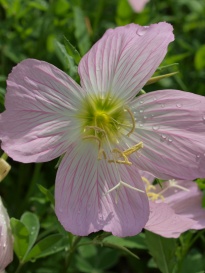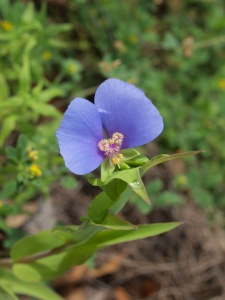There is something joyous about a field of flowers. When nature repeats with reliability, like the appearance of the bluebonnets, it penetrates through the layers of our lives that separate us from our natural surroundings. Not only do we reconnect to seasons through plants, but it also serves as a subtle measure of the health of the ecosystem. Note all the news reports on wildflower predictions each year.
What is perhaps just as remarkable, but less remarked on, is the subsequent unfolding of flowers, annuals and biennials, through the spring. The Bluebonnets (Lupinus texensis) are among the first to appear with the occasional patch of Indian paintbrush (Castilleja coccinea) to highlight the colors tastefully.
What follows is the sequential flowering of different species. Many from the Asteraceae and while some, like scrambled eggs (Corydalis curvisiliqua) are from more obscure families like Fumariaceae. Together they form layers in the landscape in space and time. The casual manner in which the form and color of these species, frequently seen on roadsides, complement each other always strikes me as rather amusing given the effort and time someone might put in to create the same, very temporary effect. Eventually the fields of blooms give way to smaller and smaller patches until finally we arrive at the enormous sunflowers of the summer.

brown eyed susans (all yellow) together with firewheels (orange and yellos)
The ever changing mosaic of these roadside species is largely connected to environmental conditions and germination requirements. Some seeds, like those of the bluebonnets require stratification and fall rains for the plants to germinate and begin growing well before Christmas. Similarly, the firewheel (Gaillardia pulchella) seen here with brown eyed susans (Rudbeckia hirta) should be planted early as they require 70F to germinate and so may only appear the following spring if the weather warms up too quickly.

Missouri primrose (Oenothera macrocarpa

pink evening primrose (Oenothera speciosa)
While the annuals and biennials are tied to seasons through seed germination. It is possible that perennials might offer more reliable color, although their flowering (timing and profuseness) is tied to weather conditions as well.
Primrose is a common name applied to members of the genus Calylophys sp. and Oenothera sp, both found in the Onagraceae. These species provide alternate yellows to the early daisies and occasionally delicate pink.

wine cup
The purple/blue range of the spectrum can be found in the wine cup (Callirhoe digitata). A perennial with a deep tap-root, it has leaves close to the ground year round, but sends dramatic purple flowers up over grasses and neighbouring plants early in the spring. A more upright form is that of Widow’s tears (Commelina erecta) which, while
low (growing about 1-3 ft tall), offers a vertical line in contrast to the Purple prairie verbena (Glandularia bipinnatifida) that grows profusely with a relaxed habit that is frequently covered with butterflies.
Hummingbirds find a food source in the bright red cedar sage (Salvia roemeriana). With it’s attractive leaf it brightens shady spots from early spring until mid summer, providing dramatic contrast to the white caliche stone and brown mulch found in forested areas.
Spring in Texas clearly offers a diverse palette of color and form. To mimic the natural sequence and arrangement of wildflowers one must understand both germination and flowering requirements of the plants selected. Like a puppet master it is all in the timing of seed application, watering and of course placing of both perennials and the annuals/biennials. Can you imagine selecting 4 or 5 species to place in an area for a spring show? Can you imagine a “meadow” effect in say a 3×3 ft area? What are the important criteria that we can take from nature to implement in design in order to attain that effortless look of sequential color?











